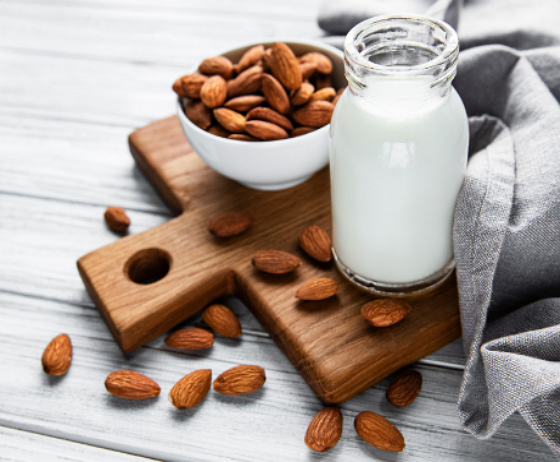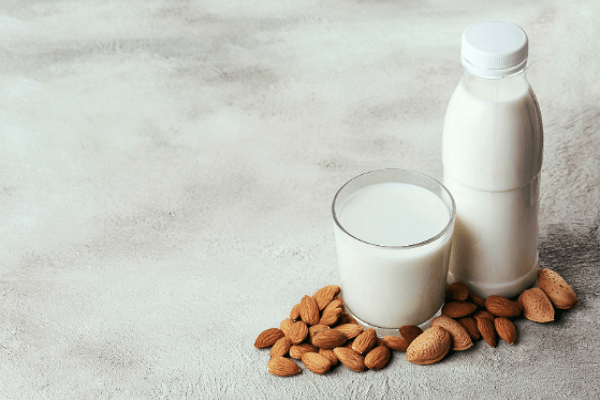Over the years almond milk has become popular, and people find it more tasty compared to other plant-based milk options. Almond milk is a healthful milk and light in flavor. It can be used as a substitute for dairy milk which you can use in baking goods, oatmeal, and to your coffee.
In this article, I’ll take you through its health benefits, and let’s discover how is almond milk made.
What Is Almond Milk?

Almond milk is known worldwide but it is native to the Middle East. The nuts are consumed as snacks, crushed into flour, and even made into creamy, dairy-free milk.
It is one of the most popular almond products due to a key feature: it is lactose-free. This milk is a healthful alternative to dairy drinks for vegans and persons with lactose sensitivity. Others adore its nutty flavor.
You can drink this milk on its own or use it in recipes that call for animal or plant-based milk. Aside from its delicious taste, it has some fairly significant health benefits.
Benefits of Almond Milk
Below are some of the health benefits of consuming almond milk:
1. Low in Carbs and Calories
Unsweetened almond milk is lower in sugars and carbs than animal milk. It comprises up to 80% less calories compared with dairy milk. It is a drink with a low glycemic index. As a result, it is less prone to produce blood sugar increase.
2. Promotes Weight Management
Weight loss is frequently achieved or aided by reducing calorie intake from eating. Switching to this plant-based milk may help people reduce their calorie intake because it has fewer calories than ordinary dairy milk.
Many commercial versions of almond milk, however, are sweetened or flavored with added sugars, making them higher in calories. If you’re concerned, you should read the nutrition label and ingredient list.
3. Rich in Vitamin E
This milk is high in vitamin E, which is beneficial to your immune system and blood vessels. Vitamin E is an antioxidant that protects your cells from the impacts of harmful chemicals known as free radicals. Additionally, vitamin E may aid in the body’s ability to burn fat.
4. Dairy-free Milk
Because it is not derived from animals, this milk has no lactose. As a result, it’s an excellent milk substitute for those who are lactose intolerant. It is also good for vegans.
5. Promotes Heart Health
It promotes heart health for a variety of reasons. For starters, it is naturally low in saturated fat, which has been linked to heart disease. Individuals can lower their intake of dangerous fats by selecting this milk over dairy milk. Furthermore, almond milk contains no cholesterol, which is another risk factor for heart disease.
In addition, it contains vitamin E, an antioxidant that aids in the prevention of cardiovascular disease. It also contains potassium, which helps to maintain healthy blood pressure levels. Lastly, it is a plant-based option that may aid in weight maintenance, lowering the risk of heart-related issues.
How is Almond Milk Made Commercially

Commercially produced almond milk is made through a process that involves several steps. It begins with soaking almonds in water, followed by blending and straining to extract the liquid. Here’s the process and the ingredients commonly used:
Soaking
Raw almonds are soaked in water for several hours or overnight. This helps soften the almonds, making them simpler to blend and extract milk from.
Blending
The soaked almonds are then blended with fresh water to create a smooth mixture. The ratio of almonds to water varies depending on the desired consistency and flavor of the final product.
Straining
The blended mixture is strained through a fine mesh or cheesecloth to remove the almond pulp, resulting in a creamy liquid. This step helps achieve a smoother texture and removes any remaining solids.
Flavoring and Stabilizing
To enhance the taste and texture, commercial almond milk often includes additional ingredients such as sweeteners, emulsifiers, and flavorings. These ingredients are added in controlled amounts to ensure consistency across batches.
Fortification
Some brands fortify their almond milk with vitamins and minerals, such as calcium, vitamin D, and vitamin E, to mimic the nutritional profile of dairy milk.
The milk is homogenized and pasteurized to ensure safety, extend shelf life, and maintain quality. The resulting product is a creamy, dairy-free alternative to milk, suitable for vegans, lactose-intolerant individuals, or those who simply prefer plant-based options.
How to Make Almond Milk at Home

Making your own almond milk at home is simple. Almonds of various types and shapes can be used. You can flavor and sweeten it to your liking, or simply delight it as is.
The better part is that you can manage everything that goes into your dairy-free milk by preparing it yourself.
Another thing is that you can use this recipe to produce dairy-free milk from other nuts as well, such as cashews, pistachios, hazelnuts, and macadamias.
Here’s what you’ll need:
- 1 cup raw almonds
- 4 cups filtered water (plus more for soaking)
- Sweeteners (optional)
- Flavorings (optional)
- Nut milk bag or cheesecloth
- Blender
- Bowl or pitcher for straining
Instructions:
Soak the Almonds
Place the raw almonds in a bowl and cover them with water. Allow them to soak overnight or for at least 6-8 hours. Soaking helps soften the almonds and makes them easier to blend.
Rinse the Almonds
After soaking, drain the almonds and rinse them thoroughly under cold water to remove any residual debris.
Blend the Almonds
Place the soaked and rinsed almonds in a blender along with 4 cups of filtered water. Blend on high speed for about 2-3 minutes or until you achieve a creamy, smooth consistency.
Strain the Mixture
Set a nut milk bag or cheesecloth over a bowl or pitcher, ensuring there’s enough room to catch the liquid. Pour the blended almond mixture into the bag or cheesecloth.
Squeeze and Strain
Gently squeeze and twist the bag or cheesecloth to extract as much liquid as possible. Continue until you’re left with mostly dry almond pulp.
Optional: Sweeten and Flavor
If desired, add sweeteners like dates, honey, maple syrup, or any other preferred sweetener, along with flavorings such as vanilla extract, cocoa powder, or cinnamon to the strained almond milk. Blend again briefly to incorporate the flavors.
Store and Refrigerate
Pour the freshly made almond milk into a clean container with a tight-fitting lid. Store it in the refrigerator and consume it within 3-4 days. Be sure to shake well before each use, as separation is natural.
That’s it! You now have homemade almond milk ready to enjoy. Remember to save the almond pulp, as it can be used in various recipes like smoothies, baked goods, or as a topping for yogurt or oatmeal.
Is Drinking Homemade Almond Milk Good For You?
Drinking homemade almond milk can be a healthy choice as it is often free from additives and sweeteners found in store-bought options. It can provide beneficial nutrients like vitamin E and healthy fats while being low in calories and cholesterol-free. However, individuals with almond allergies or digestive issues should exercise caution. Consider personal dietary needs and the environmental impact of almond production when deciding if homemade almond milk is a good fit for you.
FAQs
What are the ingredients needed to make almond milk?
The main ingredients required to make this milk are almonds and water. However, some recipes may include additional ingredients like sweeteners (such as dates or maple syrup) or flavorings (such as vanilla extract).
What equipment is needed to make almond milk?
To make your own, you’ll typically need a blender or food processor to blend the soaked almonds with water. You’ll also need a nut milk bag, cheesecloth, or a fine-mesh strainer to strain the mixture and separate the almond pulp from the liquid.
How long do you need to soak the almonds before making almond milk?
It is recommended to soak almonds for up to 8 hours before making this milk. Soaking helps soften the almonds, making them easier to blend and extract the milk.
Can you use unsoaked almonds to make milk?
While it is possible to make almond milk with unsoaked almonds, soaking them prior to blending is generally preferred. Soaking helps improve the texture and flavor of the milk and also makes it easier to strain the mixture.
How do you sweeten almond milk?
It can be sweetened by adding natural sweeteners such as dates, maple syrup, honey, or agave syrup. These sweeteners can be blended with the almonds and water during the preparation process.
How long does homemade almond milk last?
Homemade almond milk typically lasts for about 3-5 days when stored in a sealed container in the refrigerator. However, it is important to note that this homemade milk may separate over time, so it’s advisable to give it a good shake before using it.
Can almond milk be used as a substitute for cow’s milk in recipes?
Yes, it can be used as a substitute for cow’s milk in many recipes, including baked goods, smoothies, and sauces. However, it’s important to note that the milk has a slightly different taste and consistency compared to cow’s milk, which may affect the final result of some recipes.
Is almond milk suitable for people with nut allergies?
No, it is not suitable for individuals with nut allergies since it is made from almonds. People with nut allergies should avoid consuming almond milk and opt for alternative plant-based milk like soy milk, rice milk, or oat milk.
Conclusion
In conclusion, the process of making almond milk involves a few simple steps that result in a nutritious and dairy-free alternative to traditional milk. From soaking and blending almonds to straining and sweetening the liquid, each stage contributes to creating a smooth and creamy beverage. As the popularity of plant-based milk continues to grow, understanding how is almond milk made allows us to appreciate its natural goodness and make informed choices for a healthier lifestyle.



Comments are closed.